Catching up to workforce 2020

We’re fast approaching a new decade of work, and we’ve been waxing poetic about the Future of Work what seems like forever. What have we accomplished in the two decades since Y2K? What did we do in 2019 to move our organization toward the “Future of Work,” which is actually happening now?
We begin every year with lofty goals for the organization and for our people function. I hope, like performance reviews of old, we don’t evaluate past performance and plan for ongoing performance only once per year and through the rearview mirror. I hope we are looking around corners, focused on a future state and common vision, continually optimizing our strategy and practices based on real-time observation and timely reaction to what we’re seeing and how the market is shifting. That being said, it helps to understand the broad-sweeping shifts shaping our industry and function. Reacting to the demands of the business and the expectations of talent will leave us chasing the last decade rather than proactively shaping and creating Workforce 2020 and beyond.
That’s where trends and insights play a key role. If we understand the needs of our modern organizations, the evolving expectations of the workforce upon whom we rely to deliver to the market and our customers, and the availability of innovative solutions and techniques to power experiences and drive outcomes, we can better shape an organizational digital strategy that spans our workforce goals. In other words, these themes shape our people priorities. More importantly, they help us close the gap between the world we live in outside of work and the world of work.
Stop thinking technology, start thinking digital
That’s why every year I aim to forecast and explain the major shifts we’ll see in Human Resources and Digital Transformation. Last year was no exception: How true that Mindset, People, and Process would emerge as the most important part of Digital Transformation in 2019. “Digital Transformation is going to be on the headline of every magazine,” I asserted, and technology is only one small piece of the equation for success. If we think about technology alone, we’re missing the biggest opportunity of true transformation, which is Workforce Experience.
If we understand the needs of our modern organizations, the evolving expectations of the workforce, and the availability of innovative solutions and techniques to power experiences and drive outcomes, we can better shape an organizational digital stra-tegy that spans our workforce goals
Digital transformation requires both a complete approach and a shared vision for the future, one that arcs every function: IT, operations, HR, and so on. This digital vision should be focused on the personas of your people with an understanding of how, where, and why they work. Your workforce is diverse and multifaceted. You need to understand who makes up your workforce, how they work, in what channels they best receive information, and the moments that matter most to them. This is how you transform workforce experience. Technology is the fuel for this, not the vehicle.
This pivotal DIGITAL theme permeates everything else we saw come about in 2019:
- The shift to a digital way of thinking allows us to fully and finally embrace workforce experience as the most important HR/people priority. Workforce Experience is not a buzzword. We live in an experience economy, and designing and delivering experiences for people and how they feel when they work in your organization is what will help you hire them, train and develop them, make them want to stay, and deliver excellent service to your customers. Experience is 20 percent transaction (completion of tasks) and 80 percent interaction (where trust is built).
- We got more specific in the definition and applications of AI in 2019. We know the acronym as Artificial Intelligence, but we’re not there yet and don’t need to be if you consider the value of augmented intelligence. This more narrow sense of AI, where machines augment our intelligence and capabilities, has the ability to improve experiences when working with systems. Using math, logic, and pattern and anomaly detection, “AI” defined as Augmented Intelligence can create an improved transaction for a better experience.
- The market is no longer buying HR tech because they have to for compliance purposes but because it supports an overall organizational people strategy. The value curve for the HR technology is changing. We don’t need to buy one solution to support 100 percent of our needs. We live in an app-driven, point solution world. Getting stuff done requires a lot of different capabilities, and you may not get them all in one place. HR needs to decide what they want to be great at versus what it’s OK to be just OK at - then select best in breed technology where they need to be best of class. Don’t get me wrong: a consistent user interface is important, but a consistent workforce experience is even more important.
- Yes, that means back to the future for integrations. Our experience layer, what the workforce interacts with, is going to drive integration and a return to best in breed buying strategy.
- Digital Transformation has stolen the show over technology transitions. Technology transition gets our business nowhere except on a new piece of technology. Think beyond the technology; Phase I is more important than ever. If Phase I (the experience) doesn’t add more value than what’s already being delivered today, you’ve gone nowhere. Reinvent versus re-do as you move from one technology to another. That’s the shift from technology to digital. Talent Management 2.0 is still being born, but there’s progress. Talent Management 1.0 was about automating things that had previously been done on paper and were not tracked electronically, like performance reviews. 1.0 afforded us the ability to know if they were getting done (compliance), but we had no way of knowing whether they were being done effectively (business value). Talent management 2.0 sees the center of gravity shifting from completing transactions and tasks to a new mindset where technology can be leveraged to promote better experience, engagement, and improved performance of the organization. This requires we design for the customer, your business/line managers/team leaders, and not for the simple sake of HR getting the data they need. Talent Management 1.0 is taking a physical once per year; Talent Management 2.0 is looking at your heart rate with a wearable heart rate monitor so you can make decisions today, in real time, not after your annual physical.
- Knowledge management and learning management have been freed from old shackles. There’s too much left on the table if we leave it to organizations alone to push out information, knowledge, and learning in traditional boxes. Knowledge and learning in the outside world is real-time, online, with video and rich content. At work, learning is starting to become similarly personalized; it understands what job and role you’re in, where you might want to go and what skills you might like to build. It’s also personal in that it allows each of us to share with others, allowing learning go viral, not relying on the organization to discover, organize, and deliver it alone. This personalization, delivery, and experience is data-driven, placing even more emphasis on the need for a data strategy.
- Make way for experience CoEs. In a traditional Center of Excellence, there’s strategy, policy and delivery. Employees don’t care if they’re talking to Employee Relations or Compensation or Recruiting or Performance or Comp or Learning or You-Name-It Department, yet we silo every one of our Centers of Excellence in this way. We need to centralize delivery if we want the workforce to have one seamless, frictionless experience. Look for the advent of Experience Agents, an Experience COE, and Experience Leaders.
- When you do all of the above, your HRBPs can be proactive, focus on predictive intelligence versus data, and tied to the business rather than tied to the HR department. This is where you find balance between high-touch digital versus high-touch human. If you’re truly changing experience, you can’t allow HRBPs to continue to do work for people. You need to address HRBPs - including their work and skills - as you shift focus to servicing the workforce.
- The role of the HRBP has changed forever. If you could have put a tattoo on your body in 2019 that captured everything, it would be “DESIGN.” Design is the single ingredient that drastically increases the likelihood of success in everything else. Design also begs the concepts of intentionality and sequencing. Design with intentionality to get the desired outputs and the sequence through which we complete actions. Intentionality is the difference between designing a 3-bedroom house and designing a house for the way you actually live.
- People Intelligence is slow to move to center stage, but it still needs to. Why does Amazon or LinkedIn know more about your people than you do? Because they have a very specific intent about what they want to do with the data they collect. We need the same intent where we look to gain insights that are predictive and prescriptive. This is how to think about analytics; not reporting for the sake of reporting, leaving the user to figure out how to use the data. Data needs to be clean, organized, leverage augmented intelligence, and interpreted to tell the right story. That kind of surgical precision and approach leading to action is what will move HR data & analytics to people intelligence.
If you could have put a tattoo on your body in 2019 that captured everything, it would be “design.” Design is the single ingredient that drastically increases the likelihood of success in everything else
All of these shifts require a new mindset and new skills for HR: skills like value creation and marketing, storytelling, persona design to capture the mindset of people in your workforce, enhancing process design as an experience path, and design capabilities. An experience economy requires developing these skills as core capabilities within our organizations. And all of this requires Empathy. Shifting our focus to the workforce. Thinking differently. Designing an experience for the empty chair rather than for the HR user. Workforce 2020 will be about the workforce, and it’s about time.
















